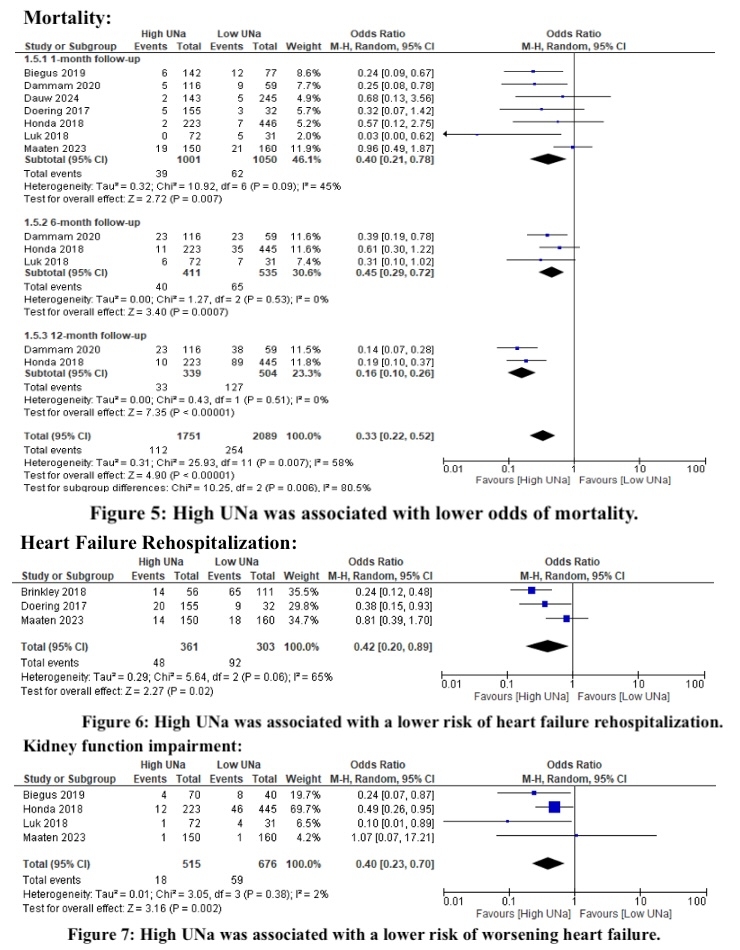Final ID: MDP1397
The Association Between Urinary Sodium Concentration (UNa) and Outcomes of Acute Heart Failure in Patients Undergoing Diuretic Therapy: A Systematic Review and Meta-Analysis
Abstract Body (Do not enter title and authors here): Introduction: The measurement of Urinary Sodium Concentration (UNa) is a pivotal biomarker in managing Acute Heart Failure (AHF), offering a non-invasive and readily accessible means to evaluate diuretic response. This systematic review and meta-analysis is designed to investigate the correlation between UNa levels and patient-centric outcomes in AHF, aiming to validate the evidence base and refine clinical practice. Methods: This systematic review and meta-analysis were conducted in accordance with PRISMA guidelines. We systematically searched PubMed, Cochrane Central, Scopus, Google Scholar, and ClinicalTrials.gov from their inception to May 2024. Our search included randomized controlled trials (RCTs) and observational studies comparing outcomes between acute heart failure (AHF) patients with high urinary sodium concentration (UNa) and those with low UNa. Results: The analysis included 12 studies comprising 5 RCTs and 7 observational studies, incorporating a total of 8,743 AHF patients. In the high UNa group, pooled data demonstrated significantly higher urinary output (MD 534.49 ml, 95% CI 348.48 to 720.49; P < 0.00001) and increased weight loss (MD 1.15 kg, 95% CI 0.45 to 1.85; P < 0.001). Additionally, there was a lower risk of renal function decline (OR 0.48, 95% CI 0.24 to 0.97; P < 0.04). Patients with high urinary sodium had a shorter mean hospital stay of 7.6 days compared to 8.8 days for those with low UNa, with an overall reduction in length of stay (MD -1.38 days, 95% CI -2.44 to -0.32; P < 0.01). Mortality was also lower in the high UNa group, particularly over longer follow-up periods: at 1-month follow-up (OR 0.40, 95% CI 0.21 to 0.78; P = 0.007), at 6-month follow-up (OR 0.45, 95% CI 0.29 to 0.72; P = 0.0007), and at 12-month follow-up (OR 0.16, 95% CI 0.16 to 0.26; P < 0.00001). Furthermore, the high UNa group exhibited a lower risk of worsening heart failure requiring inotropes (OR 0.40, 95% CI 0.23 to 0.70; P = 0.002) and a reduced incidence of heart failure rehospitalization (OR 0.42, 95% CI 0.20 to 0.89; P = 0.02). Conclusion: High urinary sodium concentration is strongly associated with improved clinical outcomes in acute heart failure, including greater urinary output, increased weight loss, shorter hospital stays, and reduced risks of renal function decline, mortality, worsening heart failure, and rehospitalization.
More abstracts on this topic:
Impact Of Admission Timing On Management And In-Hospital Outcomes In Acute Heart Failure: Insight From The CAN-HF Registry
Alshakhs Abdulmohsen, Moghaddam Nima, Makedonski Petko, Hawkins Nathaniel, Mckelvie Robert, Poon Stephanie, Honos George, Ezekowitz Justin, Zieroth Shelley, Virani Sean
β1 Adrenergic Receptor Autoantibodies Promote Heart Failure Though Activation of Prostaglandin E2 Receptor EP1/Phosphodiesterase 4B PathwayCao Ning, Qiu Hui, Li Hongwei


